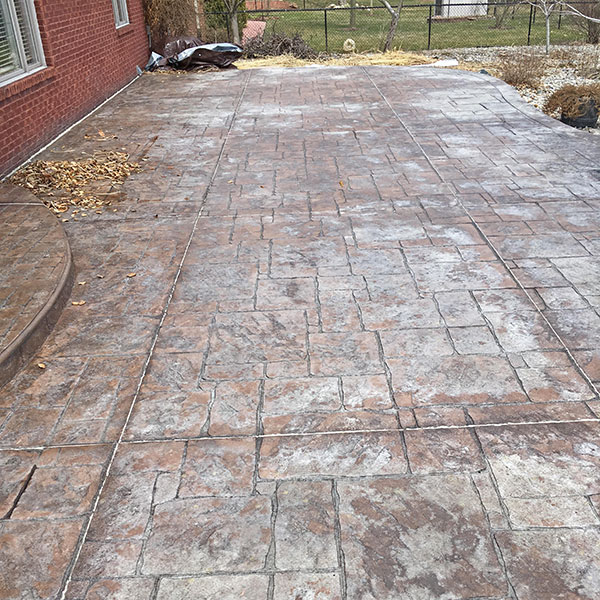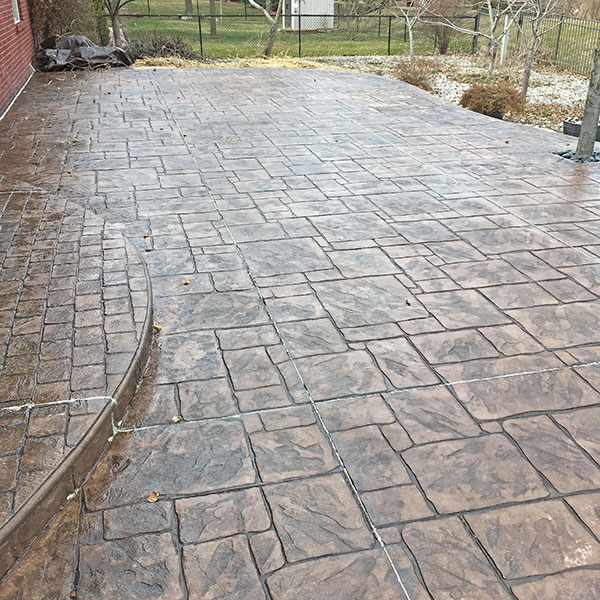A Solvent That Works Wonders


A stamped concrete patio before and after a sealer treatment done by Deccon Concrete Restoration.
*Please note that the fix described in this article pertains only to some solvent-based acrylic sealers. It does not work with water-based acrylic sealers.
Acrylic concrete sealer is something that almost all decorative concrete contractors and their customers have encountered. For the fact that acrylic sealers are economical and easy to apply, a majority of stamped concrete is coated with it.
The trouble with acrylic sealers is that they’re not very durable. It weathers and wears off rather quickly, lasting only about two years. Furthermore, it is prone to dulling, hazing, and whitening (also referred to as”blushing”).
To understand acrylic sealer problems, we must first realize what the product is. It is a mixture of two components, solid acrylic particles, and liquids. The liquid portion of sealers are known as carriers because it is how the solid particles are “carried” to the concrete surface.
In water-based acrylic sealers, the “carrier” is water. In solvent-based acrylic sealers, the carrier can be xylene, acetone, or several other strong solvents. The solid acrylic particles are what remain on the concrete surface to form a film after the carrier has evaporated. This film repels moisture and some stains in much the same way as a raincoat protects your body. The film not only seals the concrete but also drastically enhances its color and appearance.
Unfortunately, many homeowners are under the impression sealer will last forever, and this is just not the case. When using acrylic sealers, this is not possible without ongoing maintenance.
Consider the following scenario:
A contractor gets a call from a homeowner reporting that his 6-month-old stamped concrete is getting dull, or that the sealer is gone. The contractor tells the owner that it just needs to be resealed. Another coat of sealer is applied, and the concrete looks excellent …for a few
months. Then it gets dull again or even starts to haze and whiten. You add another coating of sealer, and everything appears good… for a little while. Etc., etc., etc.
Trying to fix a sealer issue with more sealer is a terrible mistake! The problem with dull stamped concrete is often not that the sealer is gone, the sealer is worn and abraded to the point that it is no longer transparent. Similar to scuffing a piece of plexiglass with sandpaper, acrylic sealer becomes hazy or even opaque when abraded. The sealer is still there, but it’s not shiny anymore, and you can no longer see through it.
Applying more sealer works temporarily because the fresh sealer introduces a solvent such as xylene (the sealer’s carrier) to the surface. The solvent re-melts the existing, dull sealer and allows it to combine with the new sealer and fill in all the tiny scratches. The sealer becomes
crystal clear again.
So the problem is solved, correct? NO!
Remember the scenario above where the gloss was temporary? The reason the sealer kept hazing in a relatively short time was not that the sealer was gone, or even that it was scuffed. Ultimately applying more sealer created problems because it caused too high of a build-up of
sealer.
You see, moisture in the concrete could not evaporate through the overly-thick coat of sealer. As a result, the sealer lifts and detaches from the surface. Similar to bubbles beneath a poorly applied automobile window tinting, a delaminated sealer appears as white or hazy spots.
But how does moisture get into concrete in the first place, even if it’s sealed? It can happen in several ways. Perhaps it seeped in through the control joints or other cracks. More likely, rainwater migrated beneath the slab from the surrounding landscape.
No matter how water gets underneath the slab, the concrete’s pores wick moisture up like a sponge. If the moisture can’t evaporate, it causes the sealer to haze as it tries to escape the surface.
If applying additional sealer is wrong, how can you fix dull or whitened sealer?
For correcting concrete sealer issues, few products can compare with xylene (also called xylol). As noted above, this strong solvent is the liquid part of many film-forming concrete sealers. It is readily available at any home center, paint store, or hardware store.
By applying a coat of straight xylene, it breaks down or re-melts the coating of sealer that is already on the surface. When the xylene evaporates from the reconstituted sealer, it leaves the acrylic solids crystal clear and shiny like new. And all without adding another layer of
solids that would create an unacceptable build-up.
The best way to apply xylene is by flooding it onto the surface with an industrial metal pump-up sprayer. If enough is applied, the xylene should melt the sealer through to the surface of the concrete before it evaporates.
In conclusion, applying xylene is a great, inexpensive way to rejuvenate dull or whitened sealer. However, be cautious when using it. The fumes can ignite, and any solvent can be harmful to your health. Be sure to read all warnings and technical data before attempting a repair and wear all appropriate personal protective equipment.
Check out more of our blogs by clicking here.
FOLLOW US ON

Recent Comments